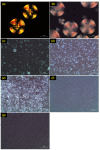Relationship between the Stereocomplex Crystallization Behavior and Mechanical Properties of PLLA/PDLA Blends
- PMID: 34199577
- PMCID: PMC8199684
- DOI: 10.3390/polym13111851
Relationship between the Stereocomplex Crystallization Behavior and Mechanical Properties of PLLA/PDLA Blends
Abstract
Poly (l-lactic acid) (PLLA) is a promising biomedical polymer material with a wide range of applications. The diverse enantiomeric forms of PLLA provide great opportunities for thermal and mechanical enhancement through stereocomplex formation. The addition of poly (d-lactic acid) (PDLA) as a nucleation agent and the formation of stereocomplex crystallization (SC) have been proven to be an effective method to improve the crystallization and mechanical properties of the PLLA. In this study, PLLA was blended with different amounts of PDLA through a melt blending process and their properties were calculated. The effect of the PDLA on the crystallization behavior, thermal, and mechanical properties of PLLA were investigated systematically by thermogravimetric analysis (TGA), differential scanning calorimetry (DSC), X-ray diffraction (XRD), polarized optical microscopy (POM), dynamic mechanical analysis (DMA), and tensile test. Based on our findings, SC formed easily when PDLA content was increased, and acts as nucleation sites. Both SC and homo crystals (HC) were observed in the PLLA/PDLA blends. As the content of PDLA increased, the degree of crystallization increased, and the mechanical strength also increased.
Keywords: PDLA; PLLA; homo crystallization; mechanical properties; stereocomplex crystallization.
Conflict of interest statement
The authors declare no conflict of interest.
Figures









Similar articles
-
Effect of molecular weight of polyethylene glycol on crystallization behaviors, thermal properties and tensile performance of polylactic acid stereocomplexes.RSC Adv. 2020 Nov 18;10(69):42120-42127. doi: 10.1039/d0ra08699a. eCollection 2020 Nov 17. RSC Adv. 2020. PMID: 35516761 Free PMC article.
-
Effect of stereocomplex crystal and flexible segments on the crystallization and tensile behavior of poly(l-lactide).RSC Adv. 2018 Aug 9;8(50):28453-28460. doi: 10.1039/c8ra05355c. eCollection 2018 Aug 7. RSC Adv. 2018. PMID: 35542484 Free PMC article.
-
Competitive Stereocomplexation and Homocrystallization Behaviors in the Poly(lactide) Blends of PLLA and PDLA-PEG-PDLA with Controlled Block Length.Polymers (Basel). 2017 Mar 15;9(3):107. doi: 10.3390/polym9030107. Polymers (Basel). 2017. PMID: 30970786 Free PMC article.
-
Poly(lactic acid) stereocomplexes: A decade of progress.Adv Drug Deliv Rev. 2016 Dec 15;107:97-135. doi: 10.1016/j.addr.2016.04.017. Epub 2016 Apr 25. Adv Drug Deliv Rev. 2016. PMID: 27125192 Review.
-
Poly (lactic acid) blends: Processing, properties and applications.Int J Biol Macromol. 2019 Mar 15;125:307-360. doi: 10.1016/j.ijbiomac.2018.12.002. Epub 2018 Dec 7. Int J Biol Macromol. 2019. PMID: 30528997 Review.
Cited by
-
Enhancement in Crystallizability of Poly(L-Lactide) Using Stereocomplex-Polylactide Powder as a Nucleating Agent.Polymers (Basel). 2022 Sep 29;14(19):4092. doi: 10.3390/polym14194092. Polymers (Basel). 2022. PMID: 36236039 Free PMC article.
-
Effects on the crystallization behavior and biocompatibility of poly(LLA-ran-PDO-ran-GA) with poly(d-lactide) as nucleating agents.RSC Adv. 2022 Apr 6;12(17):10711-10724. doi: 10.1039/d2ra00525e. eCollection 2022 Mar 31. RSC Adv. 2022. PMID: 35424991 Free PMC article.
-
Enhanced Mechanical Properties and Anti-Inflammation of Poly(L-Lactic Acid) by Stereocomplexes of PLLA/PDLA and Surface-Modified Magnesium Hydroxide Nanoparticles.Polymers (Basel). 2022 Sep 10;14(18):3790. doi: 10.3390/polym14183790. Polymers (Basel). 2022. PMID: 36145934 Free PMC article.
-
Advanced 3D Magnetic Scaffolds for Tumor-Related Bone Defects.Int J Mol Sci. 2022 Dec 19;23(24):16190. doi: 10.3390/ijms232416190. Int J Mol Sci. 2022. PMID: 36555827 Free PMC article. Review.
-
Just around the Corner: Advances in the Optimization of Yeasts and Filamentous Fungi for Lactic Acid Production.J Fungi (Basel). 2024 Mar 9;10(3):207. doi: 10.3390/jof10030207. J Fungi (Basel). 2024. PMID: 38535215 Free PMC article. Review.
References
-
- Nair L.S., Laurencin C.T. Biodegradable polymers as biomaterials. Prog. Polym. Sci. 2007;32:762–798. doi: 10.1016/j.progpolymsci.2007.05.017. - DOI
-
- Södergård A., Stolt M. Properties of lactic acid based polymers and their correlation with composition. Prog. Polym. Sci. 2002;27:1123–1163. doi: 10.1016/s0079-6700(02)00012-6. - DOI
-
- Mano J., Ribelles J.G., Alves N., Sanchez M.S. Glass transition dynamics and structural relaxation of PLLA studied by DSC: Influence of crystallinity. Polymer. 2005;46:8258–8265. doi: 10.1016/j.polymer.2005.06.096. - DOI
LinkOut - more resources
Full Text Sources
Research Materials

